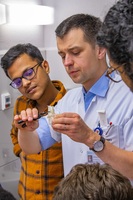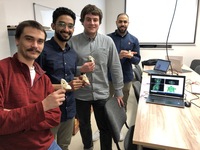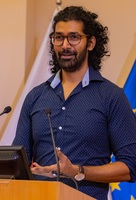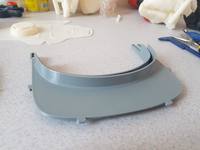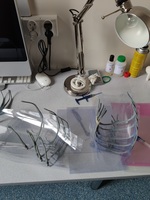The MUG students manufacture protective 3D face shields for medical staff
3.04.2020
Over 200 protective face shields that will aid the medical services in their fight against the SARS-CoV-2 virus have already been manufactured by the MUG students with the use of 3D printers and practical skills acquired during an elective course supervised by Jarosław Meyer-Szary, M.D., Ph.D. from the Department of Paediatric Cardiology and Congenital Heart Defects at the MUG. The venture had been initiated by 5th year English Division medical students Marlon Souza Luis and Agastya Patel and a 6th year medical student Zuzanna Grochecka.
– I am glad that the graduates of our recent elective course on the application of 3D printing technology in medicine could put their acquired skills and knowledge into practice in such a short time and thereby, provide great aid in the fight against the COVID-19 pandemic – says Jarosław Meyer-Szary, M.D., Ph.D. The face shields are manufactured in the 3D Printing Laboratory of the Department of Paediatric Cardiology and Congenital Heart Defects at the MUG. So far, it had been used to produce mainly heart models used in the education of both patients and students, as well as to train physicians before participating in unusual procedures.
– Manufacturing of protective medical equipment is a novelty to us. However, it stands as a perfect example of the benefits of the 3D printing technology – its overall versatility and the possibility of creating, testing and improving several versions of the prototype in one day – adds Jarosław Meyer-Szary, M.D., Ph.D.
– We tested 12 improved prototypes which we found online before deciding on a model fitting our needs – explains Marlon Souza Luis. – The final design was reached after developing 6 different versions within the last 3 days, based on the feedback we received from the users who have tested our face shields first, i.e. specialists in adult cardiology, paediatric cardiology, oncological paediatrics, radiology and volunteer personnel.
As the creators emphasise, they use Zortrax 3D printers because of their simple configuration, reliability and print quality ranging from good to excellent.
– The current throughput is around 24 sets of glass covers per day. All of them are modular and reusable as the old face shields can be replaced with new – explains Marlon Souza Luis. –- Glasses can also be easily disinfected.
The widespread pandemic did not only cause a direct threat to human health and life, but also forced many medical equipment factories to close down and interrupted supply chains. The resulting shortage of personal protective equipment has become a common problem that hospitals have struggled with not only in our country but around the world since the beginning of the epidemic. The 3D printing community are continuously developing new solutions that could face this challenge. Design patters of, among others, face shields, masks, respirator parts and even entire prototypes of respirators are available online and as such can be easily downloaded and modified according to individual needs and reproduced for personal use.
Both the students and Jarosław Meyer-Szary, M.D., Ph.D., who supervises their work, recognise growing needs related to the shifting dynamics of the epidemiological situation in the country and region. Unfortunately, they have already exhausted all their personal resources of filament, i.e. thermoplastic material, from which the face shields are made and are left with no dedicated funds that could be used for their replenishment. The purchase of additional printers would also be a huge help – each would significantly increase the capacity of the Laboratory, which may soon be of great importance. If anyone would like to support the endeavour, donations can be made via the following website https://zrzutka.pl/wtbehh.
Archives
- Academic Year 2024/2025
- Academic Year 2023/2024
- Academic Year 2022/2023
- Academic Year 2021/2022
- Academic Year 2020/2021
- Academic Year 2019/2020
- Academic Year 2018/2019
- Academic Year 2017/2018
- Academic Year 2016/2017
- Academic Year 2015/2016
- Academic Year 2014/2015
- Academic Year 2013/2014
- Academic Year 2012/2013
